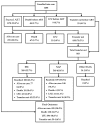HIV Care Cascade among Prisoners of the Mandalay Central Prison in Myanmar: 2011-2018
- PMID: 31906265
- PMCID: PMC7157648
- DOI: 10.3390/tropicalmed5010004
HIV Care Cascade among Prisoners of the Mandalay Central Prison in Myanmar: 2011-2018
Abstract
Prisoners have a higher HIV prevalence and higher rates of attrition from care as compared with the general population. There is no published evidence on this issue from Myanmar. We assessed (1) HIV test uptake, HIV positivity, and enrollment in care among newly admitted prisoners between 2017 and 18 (2) Treatment outcomes among HIV-positive prisoners enrolled in care between 2011 and 18. This was a cohort study involving secondary analysis of program data. Among 26,767 prisoners admitted to the Mandalay Central Prison between 2017 and 2018, 10,421 (39%) were HIV-tested, 547 (5%) were HIV-positive, and 376 (69%) were enrolled in care. Among the 1288 HIV-positive prisoners enrolled in care between 2011 and 2018, 1178 (92%) were started on antiretroviral therapy. A total of 883 (69%) were transferred out (post-release) to other health facilities, and among these, only 369 (42%) reached their destination health facilities. The final outcomes (censored on 30 June 2019) included the following: (i) Alive and in care 495 (38%), (ii) death 138 (11%), (iii) loss to follow-up 596 (46%), and (iv) transferred out after reaching the health facilities 59 (5%). We found major gaps at every step of the HIV care cascade among prisoners, both inside and outside the prison. Future research should focus on understanding the reasons for these gaps and designing appropriate interventions to fill these gaps.
Keywords: attrition; default; incarcerated populations; people living in closed settings; viral suppression.
Conflict of interest statement
The authors declare no conflict of interest.
Figures



Similar articles
-
Virological outcomes of antiretroviral therapy in Zomba central prison, Malawi; a cross-sectional study.J Int AIDS Soc. 2017 Aug 2;20(1):21623. doi: 10.7448/IAS.20.1.21623. J Int AIDS Soc. 2017. PMID: 28782332 Free PMC article.
-
Anonymous HIV surveillance with risk factor elicitation at Scotland's largest prison, Barlinnie.AIDS. 1995 Jul;9(7):801-8. doi: 10.1097/00002030-199507000-00019. AIDS. 1995. PMID: 7546427
-
Evaluation of Routine HIV Opt-Out Screening and Continuum of Care Services Following Entry into Eight Prison Reception Centers--California, 2012.MMWR Morb Mortal Wkly Rep. 2016 Feb 26;65(7):178-81. doi: 10.15585/mmwr.mm6507a3. MMWR Morb Mortal Wkly Rep. 2016. PMID: 26914322
-
Managing HIV/AIDS in correctional settings.Curr HIV/AIDS Rep. 2005 Nov;2(4):165-70. doi: 10.1007/s11904-005-0011-9. Curr HIV/AIDS Rep. 2005. PMID: 16343373 Review.
-
Human immunodeficiency virus in correctional facilities: a review.Clin Infect Dis. 2002 Aug 1;35(3):305-12. doi: 10.1086/341418. Epub 2002 Jul 3. Clin Infect Dis. 2002. PMID: 12115097 Review.
Cited by
-
Prevalence of sexually transmitted infections and associated risk behaviors in prisoners: A systematic review.Health Sci Rep. 2022 Sep 15;5(5):e819. doi: 10.1002/hsr2.819. eCollection 2022 Sep. Health Sci Rep. 2022. Retraction in: Health Sci Rep. 2023 Jul 25;6(7):e1458. doi: 10.1002/hsr2.1458. PMID: 36177400 Free PMC article. Retracted.
References
-
- Joint United Nations Programme on HIV/AIDS Global HIV & AIDS Statistics—2019 Fact Sheet. [(accessed on 16 September 2019)]; Available online: https://www.unaids.org/en/resources/fact-sheet.
-
- United Nations . Transforming Our World: The 2030 Agenda For Sustainable Development. United Nations; New York, NY, USA: 2016.
-
- Joint United Nations Programme on HIV and AIDS . Ending AIDS Progress Towards the 90-90-90 Targets. Joint United Nations Programme on HIV and AIDS; Geneva, Switzerland: 2017.
-
- Institute for Criminal Policy Reserach . World Prison Population List. 12th ed. Institute for Criminal Policy Research; London, UK: 2018.
-
- United Nations Office on Drugs and Crime . First Track to End AIDS by 2030: For People in Prisons. United Nations Office on Drugs and Crime; Vienna, Austria: 2019.
LinkOut - more resources
Full Text Sources

